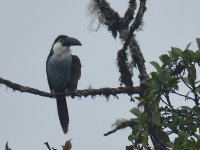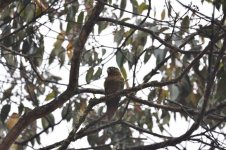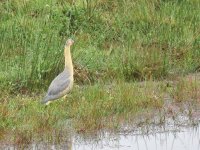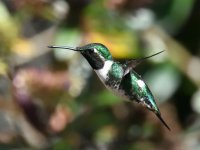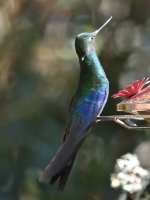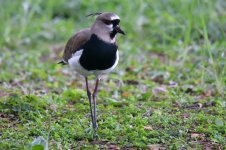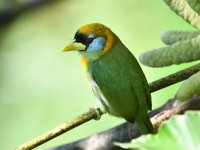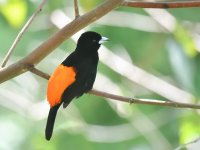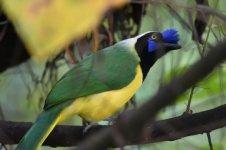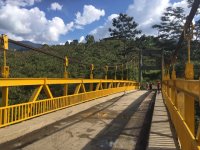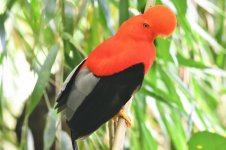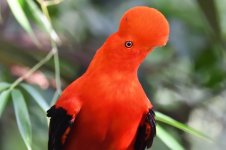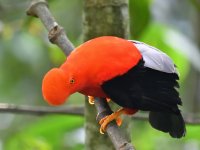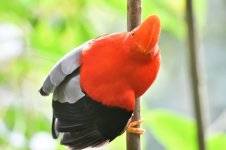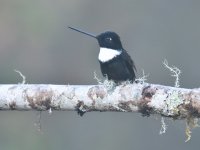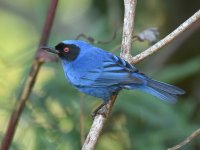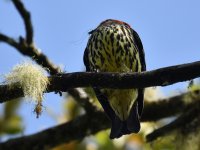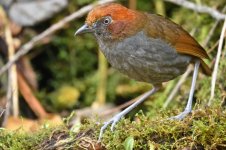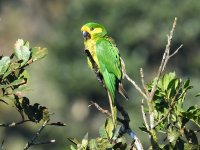kb57
Well-known member

I decided at relatively short notice to take myself off on a birding holiday while my partner was also away on a non-birding holiday in Cape Town with her friend. I picked one of the things on my birding 'bucket list' she was least bothered about sharing (experiencing a cock-of-the-rock lek), and asked Bird Forum for advice on the best place to see one. I'd already heard of the lek at Jardin, but hadn't fully appreciated it was possibly the best place to experience this species in the world, in terms of closeness of views (thanks @temmie for the advice!).
This was my first visit to South America; in fact, I'd only been to North America a couple of times during my non-birding years, picking up a few species in the course of hiking on trails and visiting parks and nature reserves. So I had no knowledge of the avifauna and no experience of visiting this part of the world. As both budget and dates were constrained, I couldn't have joined an organised tour if I'd wanted to - instead I organised travel and accommodation myself, and added on a couple of day tours by established local birders.
Before getting to the birding, I'll start with a few logistics
Flights
I booked return flights Newcastle - Amsterdam - Bogota direct on KLM - they offer the most convenient connections, with a daytime flight out and overnight flight back. I booked an extra legroom seat for the night flight, but saved money by booking 'light' tickets - hand baggage only.
I booked one internal flight from Bogota to Medellin's city airport (OAH) on Satena. Satena doesn't have such a good reputation compared to (e.g. Avianca), but OAH is way more convenient than the international airport (MED), being located next door to Terminal del Sur where the buses to Jardin depart
Accommodation
This was all booked before leaving, through Accor Hotels app for Bogota (Ibis Museo); Booking.com for Jardin (Fami-Hotel La Posada); direct with Canon de Rio Claro (via email) for the reserve accommodation there; and direct through Pro Aves for their El Paujil reserve. Correspondence with both of the reserves on emails was possible in English.
Transport
I looked at bus travel websites like Redbus and Rome to Rio to work out timetables, but not all bus companies use these. It's theoretically possible to book some buses online (e.g. the Medellin - Jardin bus), but they don't accept passports as ID (requiring a resident's 'cedula') so not possible from abroad. Looking at the websites for the bus terminals (e.g. Terminal del Sur / Norte in Medellin, main terminal in Bogota) gives a good idea of which company goes where, and even where their ticket office is located. In practice, it was always possible to turn up and buy a ticket for the next bus.
I used the Medellin Metro to get to Terminal Norte for the Rio Claro bus, which was great, while in Bogota I used the Cabify Easy Taxi app to book yellow taxi rides.
Language
All the Cloudbirders reports say Colombia is much better if you can speak Spanish...and it would've been! I started a Rosetta Stone course in Latin American Spanish about 4 weeks before I left, doing a couple of hours a day, and was able to converse freely with the locals...actually that's a slight exagerration, I learned to say things like 'the children are running', 'the apple is green', and could count up to 6. The latter in particular was a slight handicap as there are 4000 pesos to the GB pound. My lack of language skills didn't stop me getting around, but people are friendly, and it's true that a Spanish speaker would get so much more from the experience.
Safety and security
Although Colombia is known amongst birders for having over 1900 species, it is fair to say many view it less positively - my business partner's first reaction was to check our insurance policies! I never felt unsafe and didn't have any problems, but did take a few basic precautions. As a solo traveller, I thought it wise to register my travel plans (dates I'd be away, where I was visiting) - I'm an Irish citizen, so this was online at dfa.ie, but I expect other governments have a similar system. I didn't flash expensive optics around in urban areas, used a 'secure' backpack, used the taxi app in Bogota, carried a backup mobile phone, and separated my cash from my credit cards. On pharmacists advice I had a yellow fever vaccination - this isn't required in Colombia unless you're coming from an affected area, but I had the certificate if asked (I never was).
Luggage
After reading Noah Stryker's book about his world year list record, I thought if he could fit everything he needed for a year into a 40 litre backpack, I could similarly manage for 9 days - and I didn't need a laptop! I packed the essentials (Nikon D7200 / 300mm lens / 1.4x converter / second-hand Leica Ultravid bins) into a Pacsafe Venturesafe 40l backpack and regarded everything else as expendable. I made use of air sealed bags from Amazon (the sort you don't need to hoover!), used lightweight clothing, and washing flakes from Lifeventure. I used the 'All birds Colombia' iPhone app, but was pleased I took the McMullan book as well...although neither were perfect, as I'll come to later...in practice, I got everything down to under 9kg, well within my 12kg carry on allowance for KLM, and easy to carry around on my back from place to place.
Birding guides
Now for the important bit...I organised a day trip from Bogota by email with Oswaldo Cortes from Bogota Birding..his website explains the various options, I went for high-altitude one of Bioandina and La Calera hummingbird feeders. One of the top birders in Colombia I believe.
At Jardin, I wanted to visit the yellow-eared parrot site at Ventanas, above the town. I organised a day trip with Guillermo Nagy from Aramacao Tours - both the hotel and Doug Ellis at La Esperanza above Jardin (whom I corresponded with, hoped to visit, but didn't have time in the end) recommended him. Excellent birder with excellent local knowledge and contacts.
Next to follow: itinerary, and the birds!
This was my first visit to South America; in fact, I'd only been to North America a couple of times during my non-birding years, picking up a few species in the course of hiking on trails and visiting parks and nature reserves. So I had no knowledge of the avifauna and no experience of visiting this part of the world. As both budget and dates were constrained, I couldn't have joined an organised tour if I'd wanted to - instead I organised travel and accommodation myself, and added on a couple of day tours by established local birders.
Before getting to the birding, I'll start with a few logistics
Flights
I booked return flights Newcastle - Amsterdam - Bogota direct on KLM - they offer the most convenient connections, with a daytime flight out and overnight flight back. I booked an extra legroom seat for the night flight, but saved money by booking 'light' tickets - hand baggage only.
I booked one internal flight from Bogota to Medellin's city airport (OAH) on Satena. Satena doesn't have such a good reputation compared to (e.g. Avianca), but OAH is way more convenient than the international airport (MED), being located next door to Terminal del Sur where the buses to Jardin depart
Accommodation
This was all booked before leaving, through Accor Hotels app for Bogota (Ibis Museo); Booking.com for Jardin (Fami-Hotel La Posada); direct with Canon de Rio Claro (via email) for the reserve accommodation there; and direct through Pro Aves for their El Paujil reserve. Correspondence with both of the reserves on emails was possible in English.
Transport
I looked at bus travel websites like Redbus and Rome to Rio to work out timetables, but not all bus companies use these. It's theoretically possible to book some buses online (e.g. the Medellin - Jardin bus), but they don't accept passports as ID (requiring a resident's 'cedula') so not possible from abroad. Looking at the websites for the bus terminals (e.g. Terminal del Sur / Norte in Medellin, main terminal in Bogota) gives a good idea of which company goes where, and even where their ticket office is located. In practice, it was always possible to turn up and buy a ticket for the next bus.
I used the Medellin Metro to get to Terminal Norte for the Rio Claro bus, which was great, while in Bogota I used the Cabify Easy Taxi app to book yellow taxi rides.
Language
All the Cloudbirders reports say Colombia is much better if you can speak Spanish...and it would've been! I started a Rosetta Stone course in Latin American Spanish about 4 weeks before I left, doing a couple of hours a day, and was able to converse freely with the locals...actually that's a slight exagerration, I learned to say things like 'the children are running', 'the apple is green', and could count up to 6. The latter in particular was a slight handicap as there are 4000 pesos to the GB pound. My lack of language skills didn't stop me getting around, but people are friendly, and it's true that a Spanish speaker would get so much more from the experience.
Safety and security
Although Colombia is known amongst birders for having over 1900 species, it is fair to say many view it less positively - my business partner's first reaction was to check our insurance policies! I never felt unsafe and didn't have any problems, but did take a few basic precautions. As a solo traveller, I thought it wise to register my travel plans (dates I'd be away, where I was visiting) - I'm an Irish citizen, so this was online at dfa.ie, but I expect other governments have a similar system. I didn't flash expensive optics around in urban areas, used a 'secure' backpack, used the taxi app in Bogota, carried a backup mobile phone, and separated my cash from my credit cards. On pharmacists advice I had a yellow fever vaccination - this isn't required in Colombia unless you're coming from an affected area, but I had the certificate if asked (I never was).
Luggage
After reading Noah Stryker's book about his world year list record, I thought if he could fit everything he needed for a year into a 40 litre backpack, I could similarly manage for 9 days - and I didn't need a laptop! I packed the essentials (Nikon D7200 / 300mm lens / 1.4x converter / second-hand Leica Ultravid bins) into a Pacsafe Venturesafe 40l backpack and regarded everything else as expendable. I made use of air sealed bags from Amazon (the sort you don't need to hoover!), used lightweight clothing, and washing flakes from Lifeventure. I used the 'All birds Colombia' iPhone app, but was pleased I took the McMullan book as well...although neither were perfect, as I'll come to later...in practice, I got everything down to under 9kg, well within my 12kg carry on allowance for KLM, and easy to carry around on my back from place to place.
Birding guides
Now for the important bit...I organised a day trip from Bogota by email with Oswaldo Cortes from Bogota Birding..his website explains the various options, I went for high-altitude one of Bioandina and La Calera hummingbird feeders. One of the top birders in Colombia I believe.
At Jardin, I wanted to visit the yellow-eared parrot site at Ventanas, above the town. I organised a day trip with Guillermo Nagy from Aramacao Tours - both the hotel and Doug Ellis at La Esperanza above Jardin (whom I corresponded with, hoped to visit, but didn't have time in the end) recommended him. Excellent birder with excellent local knowledge and contacts.
Next to follow: itinerary, and the birds!





